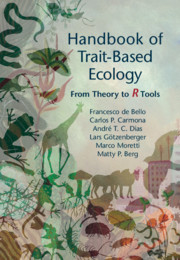Book contents
- Handbook of Trait-Based Ecology
- Handbook of Trait-Based Ecology
- Copyright page
- Epigraph
- Contents
- Preface
- 1 General Introduction
- 2 Trait Selection and Standardization
- 3 The Ecology of Differences
- 4 Response Traits and the Filtering Metaphor
- 5 Community Metrics
- 6 Intraspecific Trait Variability
- 7 Community Assembly Rules
- 8 Traits and Phylogenies
- 9 Effects of Traits on Ecosystem Processes and Services
- 10 Response and Effect Traits across Trophic Levels
- 11 Trait Sampling Strategies
- 12 Applied Trait-Based Ecology
- References
- Index
10 - Response and Effect Traits across Trophic Levels
Published online by Cambridge University Press: 08 March 2021
- Handbook of Trait-Based Ecology
- Handbook of Trait-Based Ecology
- Copyright page
- Epigraph
- Contents
- Preface
- 1 General Introduction
- 2 Trait Selection and Standardization
- 3 The Ecology of Differences
- 4 Response Traits and the Filtering Metaphor
- 5 Community Metrics
- 6 Intraspecific Trait Variability
- 7 Community Assembly Rules
- 8 Traits and Phylogenies
- 9 Effects of Traits on Ecosystem Processes and Services
- 10 Response and Effect Traits across Trophic Levels
- 11 Trait Sampling Strategies
- 12 Applied Trait-Based Ecology
- References
- Index
Summary
Chapter 10 synthesizes the concepts already introduced, regarding response and effect traits, into the so-called response--effect trait framework. It shows how such a framework can be expanded and tested across different trophic levels, thus assessing how functional traits control species interactions and the consequences of these interactions for ecosystem functioning. The concepts of ‘trophic effect' and 'response traits’ are introduced to assess how traits within a trophic level affect other trophic levels. A further discussion is provided on interesting perspectives incorporating trait-based concepts into plant--animal interaction networks, to identify both niche and neutral mechanisms driving interactions networks and the resulting ecosystem services. Finally, the importance of intraspecific trait variability in the context of species interactions, and ecosystem processes resulting from them, is discussed. The R material accompanying this chapter provides one approach on how to calculate species interaction niche.
Keywords
Information
- Type
- Chapter
- Information
- Handbook of Trait-Based EcologyFrom Theory to R Tools, pp. 194 - 209Publisher: Cambridge University PressPrint publication year: 2021
